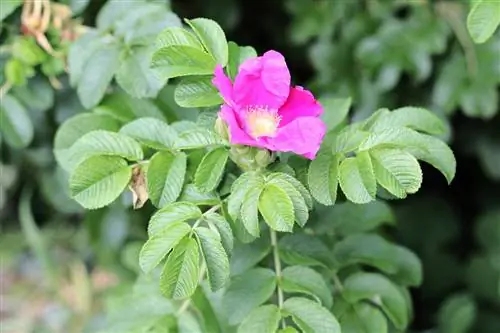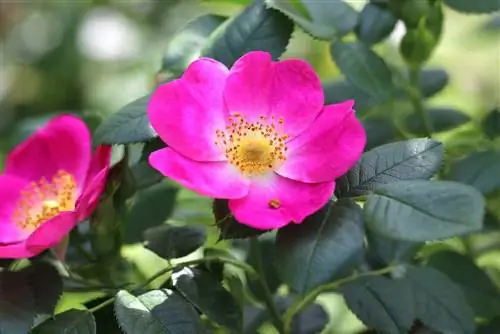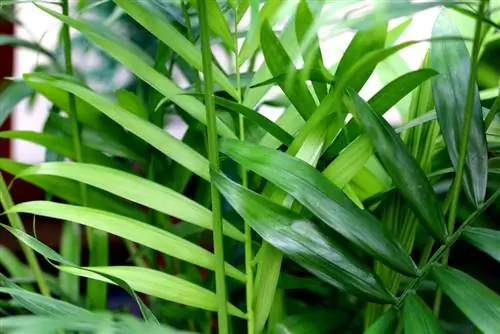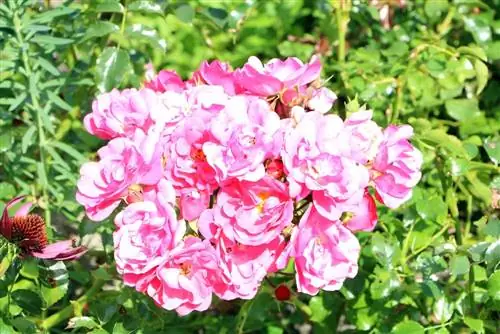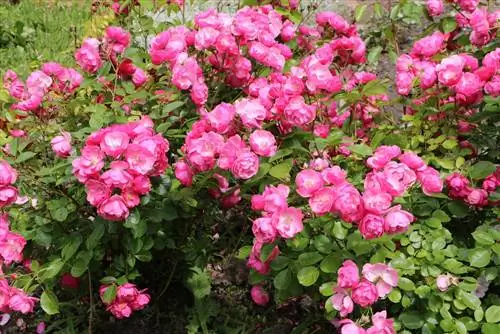- Author admin [email protected].
- Public 2023-12-17 03:39.
- Last modified 2025-01-24 12:45.
Roses can delight the gardener with their blooms. However, this only applies if they are cut correctly. Uncared for roses become lazy and age. The sticks appear untidy and provide a good basis for pests or diseases. There are a lot of things to consider when pruning roses, but it's still worth taking on the task.
General information about cutting back
- use sharp, preferably disinfected tools
- Disinfect tools when changing plants
- right time for most varieties in spring when forsythia is blooming
- Flowered flowers are removed regularly to avoid unnecessary seed formation
- Make the cut diagonally over the outwardly positioned bud
- dead wood is removed at the base
- sick wood cut back to he althy
- Regular cutting protects against aging and maintains flowering potential
- Strong pruning promotes strong new growth, weak pruning leads to weak new growth
- each type of rose is treated individually
- once flowering varieties cut after flowering
Tool
It is best to use special rose scissors to cut roses. However, it is also possible to use another secateurs. A hand saw is necessary for stronger shoots, or perhaps one with a telescopic handle for climbing roses. Another important tool is sturdy gloves that the rose thorns cannot penetrate.
Flower roses
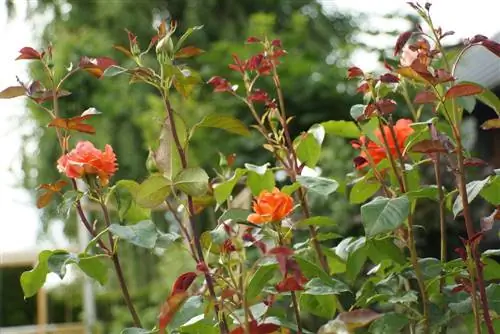
They can be cut back most vigorously. Shoots about 15 to 20 cm long remain on the stick. If it is a slow-growing variety, three he althy shoots with three eyes should remain on the stick. If the variety is one of the fast-growing varieties, 5 shoots can remain on the plant. There should be 5 buds on each shoot. The goal when pruning floribunda roses is a compact, blooming rose with a bushy character. If the shoots remain too long, the plant will literally fall apart and appear bare.
Noble roses
These roses can also be cut back heavily. Weak-growing varieties need three to four shoots, strong-growing roses need five to six. Strong shoots are cut back to five buds, weak ones to three. The goal is a rose with long, straight flower shoots. Many branches should therefore be avoided. For older specimens of noble or floribunda roses, an old, perennial shoot is always removed at the base in order to encourage the plant to sprout again.
Tip:
Weak shoots that are too thin are also removed to stimulate stronger growth.
Multi-blooming shrub roses
They are less likely to be cut. In addition, for once-flowering varieties, one cut in summer is sufficient. Shrub roses bloom on annual wood, which forms on shoots from the previous year. Since shrub roses can grow very tall, up to 300 cm, some strong, older shoots are necessary in the plant to support it. Similar to pruning fruit trees, the best and strongest five shoots are selected; these form the basic structure of the rose.
All remaining long shoots are removed at the base; the same applies to over-aged or weak shoots that did not produce many flowers the previous year. The branches on the main shoots are cut back to three to five buds, on which the flower shoots then form.
Single-blooming shrub roses
They are basically treated like other shrub roses. However, pruning is done in summer, after flowering. They are also not cut back too much as they bloom on perennial wood. For older specimens (from around 5 years old), an old, thick branch just above the ground is completely removed to encourage new growth of the rose.
Tip:
Old wood can be recognized by the color of the bark. It changes from green to yellow-brown.
Small shrub roses
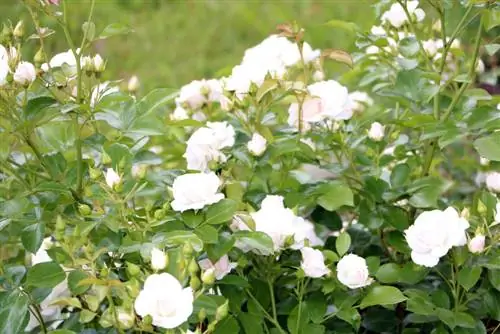
In addition to the large shrub roses, there are also varieties that can be used as ground cover. These are particularly easy to care for and are rarely cut. The main focus is on cutting dead or diseased wood. Shoots that are too dense are also removed. Heavy pruning should be done approximately every 5 years.
Climbing roses
Climbing roses are also best cut in summer; depending on their size, they are shortened by around a third. Since they usually grow on a trellis, the shoots that grow in the wrong direction and cannot be trained are removed. All secondary shoots along the main shoots are cut back to three to five buds. Overaged shoots should be removed at the base if there is a young shoot that can be trained. The ratio between young wood and old wood should be roughly balanced.
Standard roses
These little trees should also be treated like trees. When cutting, the goal is a loose, light-flooded and airy crown. The right time here is also in spring when it comes to multi-flowering varieties. Pruning of single-flowering standard stems is done after flowering. Standard roses can be cut naturally or shaped by cutting back. However, spherical shapes appear artificial. When pruning roses, about a third of the plant is removed. Shoots that are too dense, crossing or obstructing each other are removed.
Avoid mistakes
Care is taken to cut roses evenly. If shoots of different lengths remain on the rose, it may happen that they sprout and grow at different rates. The rose bush takes on a misshapen appearance. You should also avoid cutting over inwardly growing buds. The shoots would eventually interfere with each other. A straight, clean cut is important, which is why the tool should definitely be very sharp. The more uncleanly the cut is, the larger the entry point for pathogens becomes.
Tip:
However, wild shoots at the base of the plant should not be cut; they are best pulled out so that new ones do not develop in the same place. Wild shoots can be recognized by the fact that they grow out below the grafting point.
Dispose of clippings
If the roses are he althy, the clippings can be used in the garden. It can be placed in the lowest layer of mounded or raised beds. Shredded, it serves as mulch for beds or is disposed of in compost. The situation is different with sick roses. If possible, these should be disposed of outside the garden. If available, cuttings can be placed in the organic waste bin or they can go into the residual waste.


